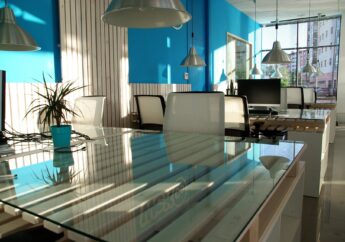Is Your Office Making You Sick? 10 Things to Consider
by Abdul Aziz Mondal Management Published on: 25 April 2018 Last Updated on: 21 May 2025

A 2012 study reported that over $576 billion in potential profits are lost due to sick days and worker’s comp. Now, obviously, there’s no way to prevent your workers from getting sick as a whole, but your office should be a safe haven. There are a number of factors that contribute to workers getting sick.
There is a matter of taking care of the presence of viruses and bacteria in the office, of course. Outside of that, there are some less obvious ways that the office space can be making workers sick. We’ve gathered the top ten things you should do if your office is making you sick.
Read on!
1. The Air Conditioner/HVAC :
The number one area that should be looked at first when trying to narrow down a source of illness. The HVAC is not only a source of comfort, but it can also be a real drain on your revenues as well. If your HVAC isn’t receiving regular maintenance, it will make your workers sick and your wallet sicker.
Air conditioners have to work much harder when the filters, vents, and air handler are encumbered by dust and dirt. A build-up of dust and foreign particulates allow toxins and allergens to accumulate. If your office HVAC system could use a proper check-up, use a competent technician like Comfort Conditioning to fix it and prevent office illness from gaining a foothold.
Your HVAC system should receive a full inspection every six months, preferably.
2. Hidden Mold and Mildew :
If your office space has a mold problem, it’s usually not visually evident until the problem is out of hand. The key is prevention, like most other illness sources on our list. Mold makes up around 80% of all office sickness causes, it’s just not known until after the fact.
The most common sources of mold will be bathrooms, break rooms, basements, and attics. Geological location will also be a strong factor as to how susceptible your office is to mold. Securing the foundation of the building from leaks is the first step to prevent mold.
This includes the roof, doorways, windows, pipes, and vents. Another overlooked source of mold spores is indoor plants and fountains. Depending on how often you water them, check below and around the pots.
3. Equipment, Computers, and Appliances :
Computers get dusty so quick in offices, yet they are cleaned the least out of all other fixtures. The fans are constantly pulling dust into them, building up over time. It is worth opening up all computers, printers, and equipment that have vents.
Even with regular dusting on the surfaces, dust eventually finds its way back out of the vents and into workers’ lungs. The best and most efficient way to handle a large office space full of computers is to keep a running rotation of computer maintenance-slash-cleaning. Doing this keeps from inconveniencing workers.
4. Steam Cleaning :
If your office has carpeting and/or rugs, you need to have those steam-cleaned every one to two months. This prevents the spread of bacteria and mold tracked into the building. All that foot traffic embeds and releases foreign allergens and agents.
This is not just a way to keep the workspace extra sanitary, it’s actually a cost-saving measure. This reduces the amount of airborne particles in the air, which therefore reduces the volume introduced to your HVAC and ventilation.
Hiring professional services to fix the issue shouldn’t be compromised. If you want the job done right, you have to pay for the best.
5. Coffee Machines, Refrigerators, Water Coolers :
These three office space staples are the biggest sources of bacteria growth and cross-contamination. Coffee machines — even industry-grade ones — can get moldy very easily if not cleaned daily. The employee fridge is also a breeding ground for all sorts of bacteria and mold
It’s worth the extra effort if you can get a janitor to clean out the fridge every week. The water cooler also stands to be sanitized every day. This keeps any mold or bacteria from multiplying along the edges and faucet.
6. Bad Employee Habits :
This is another factor for office-borne illnesses that can go unchecked. Some employees are just plain lazy, others careless. They need to be reminded to clean up their workspaces.
If this becomes a habitual problem in your office, there need to be consequences for sloppiness.
The key is to limit the amount of trash, food, and open containers exposed in the office. Even with trash bins emptied every night, trash left in them can attract rodents, pests, and parasites.
If your office attracts roaches, rats, or mites, for instance, this can result in a huge increase in airborne allergens. This also means you’ll now have to hire an exterminator to rid the office of an infestation.
Prevention is, of course, key, but you should always be prepared to guide your business through any crisis.
7. Poor Ventilation :
If you don’t have good circulation, even with clean vents and HVAC system, pollutants and allergens can still cause a problem. Poor circulation also allows more VOC, aka volatile organic compounds, to accumulate in the air. These include carbon monoxide, benzenes, styrene, asbestos, radon, and more.
No matter how clean you get the building, there are a number of sources that will be missed. Cleaning products can even contribute to VOC build-up if ventilation is not good. It is also worth remembering that with poor ventilation, the chances of mold and mildew goes up.
When the outside becomes more humid, a building can “sweat” moisture on the inside, causing water damage and potential for mold growth.
8. Stress-related Illnesses :
It’s difficult to avoid stress in the busy work environment, but there should be efforts made to reduce it. Workers handle stress in their own individual ways; some handle it better than others. It is your job to create the most accommodating work environment.
If your workers are stressed, they are more at-risk for long-term illnesses like heart disease, diabetes, and even cancer. Short-term illnesses are much more noticeable, such as high blood pressure, pre and type two diabetes, weakened immune systems, and more. You can help prevent workers from developing serious stress-related illnesses.
For example, noise-related pollution can heavily impact a worker’s productivity, as well as their stress levels. There’s an estimated 41 million people who are affected by noise-related stress at work. Better sound-proofing, smarter employee seating, and considerate work culture can reduce noise levels.
9. Communication Is Key :
This next factor regarding office-related illnesses ties into the previous point about stress. An office that feels divided or sensitive towards worker complaints will often miss issues with illness. A healthy office environment includes open communication and consideration of worker needs.
A counselor should be available to handle worker needs and complaints. This is key to managing stress and/or coworker concerns. Say, for example, a coworker is abusing power or doesn’t keep their area together–this should be corrected.
Good management protects your company and your staff.
10. Artificial and Natural Light :
Lastly, I want to cover the importance of proper lighting in your office. If workers aren’t getting enough breaks from artificial light and the office space is poorly lit, a number of issues can arise. Headaches and migraines thrive in poorly lit environments, as well as unnatural light.
Many workers don’t realize how they are affected by too much exposure to blue light, the brightest and hottest type of light. All our electronic devices are giving off this light. If the office lights are all bright LEDs or fluorescent bulbs, it can really affect workers’ health.
Light influences mood, metabolism, concentration, and energy levels. That’s why it is so difficult to fall asleep right after staring at a phone or computer screen. Try replacing bulbs with natural yellow tints and encouraging breaks outside the building.
Transform Your Office Business :
I hope this guide gives you a wider perspective on workplace illness and overall health of your business. Investing in your workspace will reward you ten-fold if you’re going for long-term success. Real wealth is built on patience and integrity, not short-term profits.
Real wealth business is all about these key tenants of small business success. It can be easy to overlook things like maintenance and “office housekeeping”. On our small business blog, we tend to focus on working smarter, not harder.
As any entrepreneur can attest, though, you will probably take on some hardships before you get the gold. It’s not cheap to keep your workplace happy, productive, and profitable, of course.
Don’t make the mistake of ignoring tried and true business advice in order to save a few bucks.
Contact us if you have any questions about growing your business and creating real wealth.
Read Also :



































































































